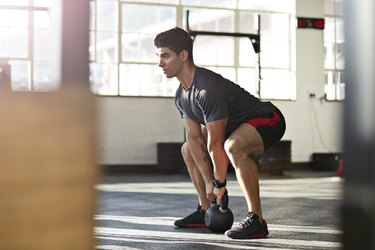
While women are often the subject of unhealthy expectations when it comes to weight and appearance, men, too, are often confronted with unrealistic imagery of washboard abs and vascular biceps.
The truth? There's no such thing as a perfect body. And looking a certain way doesn't necessarily make you healthy — or happy.
Video of the Day
Video of the Day
But there are some lifestyle habits men can introduce in order to achieve their healthiest physique (which, really, is the ideal). Consider these practices in the gym (and kitchen!) to help you lose fat, gain muscle and feel your personal best.
Strength Train to Boost Your Metabolism
You've probably heard the term "slow metabolism" thrown around, but understanding the science behind your metabolic rate will give you a better grasp of how fat loss works. Your metabolism is the process by which your body burns calories, according to Harvard Health Publishing. It's constantly working to digest food, keep your blood flowing — basically every process you need to live.
Your metabolism determines how many calories you burn in a day outside of exercise. While your metabolism is largely determined by genetics, your body composition can also speed or slow your metabolic rate. Muscle burns more calories than fat, so the higher ratio of muscle to fat you have, the more calories you'll burn each day, according to the Mayo Clinic.
For this reason, if you spend most of your time on the treadmill, it's time to venture into the weight room. Strength or resistance training is the most effective training method to help you gain muscle, according to the American Council on Exercise (ACE).
Nearly every weight-training exercise will have muscle-growing benefits, but some are better than others. The ACE recommends you structure your routines around compound movements (movements that move multiple joints or parts at once) like squats, deadlifts, push-ups and pull-ups.
Focus your exercise primarily on resistance training, but don't totally neglect your cardio. Swapping your steady-state cardio for high intensity interval training (HIIT) can help you reap some strength-gaining benefits, according to the ACE. This type of exercise involves bursts of high intensity exercise, followed by a set rest period. HIIT has been associated with both improvement in metabolic function and cardio health.
Eat Right to Gain Muscle and Lose Fat
While bacon and eggs may be your morning go-to, it takes more than pure protein to build a leaner physique. Fat loss and muscle maintenance or gain require a balance of all the macros (fat, protein and carbs) on your plate.
If you're looking to lose fat and sustain as much muscle mass as possible, you need to calculate your maintenance calories (the amount of calories you need to maintain your current weight). One option is to use an online calculator, such as the Mayo Clinic's offering, which will give you a general idea. Or, for a more precise measurement, track your average daily calories (like with a calorie counter app) for several days to a week.
Once you've established your maintenance amount, you can begin to introduce a safe, healthy cut. You may already know that 3,500 calories equals a pound of fat, according to the Mayo Clinic. While you can safely cut between 500 to 1,000 calories per day to lose weight, simply cutting calories may lead to the loss of muscle, too. This is why fat loss and weight loss aren't always the same thing.
While fat loss is a slower, more complicated process than general weight loss, it will help improve your metabolism, giving you longer-lasting results. Think of it this way: If your maintenance amount is about 2,500 calories, you can eat 2,000 calories of pizza each day and still lose weight. However, the weight you lose will likely come from muscle tissue, not fat.
Instead, fill your plate with nutrient-dense whole foods and introduce your calorie cut more slowly. As you may already know, increasing your protein intake will help promote muscle growth and fat loss, according to Harvard Health Publishing. So, focus on lean protein options like poultry or fish and aim to consume between 1 to 1.8 grams per kilogram of body weight.
At the moment, low-carb diets may be all the rage, but you need carbs to build muscle, according to the Academy of Nutrition and Dietetics. Source your carbs from whole, nutrient-rich foods like veggies, sweet potatoes and whole grains. These carb sources are filled with fiber, a nutrient that takes time to digest and is great for weight management, according to the Academy of Nutrition and Dietetics.
Don't neglect healthy fats, either — but be mindful of serving sizes: Fats contain 9 calories to the gram, while protein and carbs have only 4 calories per gram. Choose foods with healthy fats like avocados, nuts or salmon (a fatty fish) to reap the most nutritional benefits, recommends the Academy of Nutrition and Dietetics.
- Harvard Health Publishing: "The truth about metabolism"
- Mayo Clinic: "Metabolism and weight loss: How you burn calories"
- American Council on Exercise: "The BEST Resistance-training Program for Fat Loss"
- ACE: "High-intensity Interval Training: Why it Works"
- Mayo Clinic: "Counting calories: Get back to weight-loss basics"
- Harvard Health Publishing: "Preserve your muscle mass"
- Academy of Nutrition and Dietetics: "4 Keys to Strength Building and Muscle Mass"
- Academy of Nutrition and Dietetics: "Fiber"
- Baylor College of Medicine: Adult BMI and Calorie Calculator
Was this article helpful?
150 Characters Max
0/150
Thank you for sharing!
Thank you for your feedback!